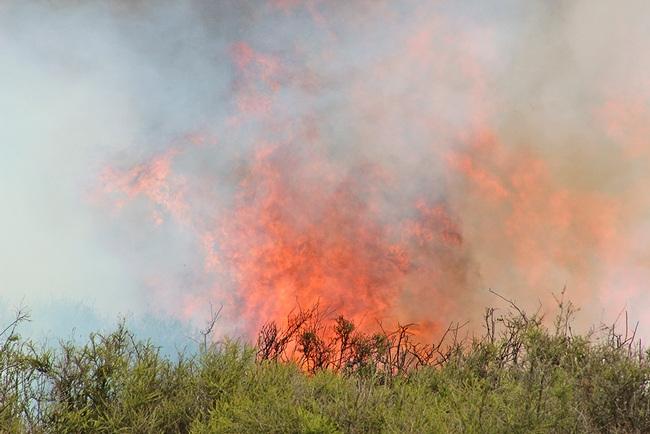Fire devoured chaparral plots at UC facility to set up a research project
The prescribed burn was carefully orchestrated by CalFire. Wide swaths of vegetation had been cleared around the 7-acre and 9-acre study areas and the weather carefully monitored before a truck-mounted “terra torch” sent streams of flammable gel into the brush, igniting a raging fire.
The fires at Hopland set up a study for a UC Berkeley doctoral student researching post-fire nitrogen cycling, provided a training ground for new CalFire recruits who will be battling blazes in the summer, and launched a new partnership between HREC and CalFire.
Chaparral shrublands, which cover about 7 percent of California natural lands, are vital California ecosystems. Chaparral contains 25 percent of the state's endemic plant and animal diversity. Nature and Native Americans burned chaparral at regular intervals for millennia, providing fresh new growth for foraging animals.
“After a chaparral fire, you typically get a flush of ephemeral wildflowers, some of which are very rare, which you haven't seen for 30 years or since the last fire,” said Lindsey Hendricks-Franco, a doctoral student at UC Berkeley who is conducting research at Hopland. “The amazing thing about these plants is their seeds can survive in the seedbank for decades. Then heat or smoke or an open canopy can stimulate them to germinate. It can be beautiful.”
The most abundant plant in Hopland chaparral, chamise, is barely fazed by fire. The plant's underground burl will soon sprout after a fire, and chamise seeds readily germinate in ash-enriched soil.
To understand the role of nitrogen cycling in the post-fire chaparral ecosystem, Hendricks-Franco and her research staff clambered over dense brush before the fire to collect soil samples and place ingenious heat sensors that document the burn temperature. After the fire, she returned to each site to collect post-treatment soil samples and heat sensors.
“It's a challenge to put sensors in a fire this hot. Most heat sensors are destroyed by the intense heat,” Hendricks-Franco said. “I painted four- by four-inch tiles with a variety of heat-sensitive paints. The paints change color at different temperatures. When I collect the tiles, they will give me an idea about the temperatures reached in the fire.”
The controlled burn at Hopland was the first step in rebuilding a partnership with CalFire, said Kim Rodrigues, who has served as the facility's director since 2014. The areas burned in April were previously burned by CalFire for fire research in the 1990s.
“We've been here since 1951 offering applied and relevant research,” Rodrigues said. “It's primarily research on ecosystem management in oak woodlands, grassland and chaparral. Fire on the landscape is a management tool.”
The 5,800-acre research facility is one of nine such centers managed by UC Agriculture and Natural Resources in a variety of California ecosystems, from high desert near the Oregon border, low desert in the Imperial Valley, Sierra Nevada forests and San Joaquin Valley farmland. Hopland is also home to 500 sheep.
Hopland CalFire battalion chief Michael Maynard was the incident commander at the April controlled burns, which he said also fulfilled CalFire objectives.
“It's good to be back here to join up with the University of California,” Maynard said. “The fire falls into our realm of training and expertise and we're helping their realm of expertise, which is research. There are 10 plots on this specific research project, so we'll be back soon.”
Maynard brought in newly hired firefighters for training on setting and controlling a prescribed burn.
“It's important that we brush up on our skills. We have seasonal employees that have hired on early and are participating. So the all-around training value is incredible and pays off later in the summer,” Maynard said.
CalFire will be back at Hopland in the fall to implement another chaparral burn so Hendricks-Franco can compare the fate of nitrogen in areas that burn before the hot, dry summer season to areas that burn in the fall and are followed by rain.
View scenes from the controlled burn in the video below:



Posted by T. Bray on May 9, 2016 at 7:01 PM